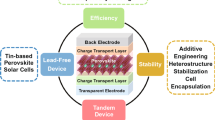Abstract
Today’s the technology based on dye-sensitized solar cells (DSSCs) has an important role in all photovoltaic system technologies. DSSCs can generate electricity with various degrees of transparency; this makes it suitable for use in various industries, especially in construction industry as smart windows. In fact DSSC can produce electricity and having natural light, simultaneously. It is obvious that DSSCs need to absorb solar radiation as much as possible. Since, the effective use of all incident lights leads to an increase in cell efficiency and this increase in efficiency is related to the amount of dye adsorbed on the surface of nanostructured electrode, so higher amount of dye for higher efficiency tends to the reduction of transparency of the cell. This paper has been attempted to investigate the relationship between these two parameters of transparency and efficiency for DSSCs by maintaining the cell stability in a long-term time interval. The results showed that the thickness of the nano-porous titanium dioxide film and the size of its nanoparticles have an important role as the photo-anode due to the absorption of the dye molecules in the DSSCs. Using the smallest size of TiO2 nano-particles in the anatase phase, and optimizing the TiO2 layer thickness by adding terpineol solvent in it, the stability of the DSSC is improved exceedingly and the level of transparency increased from 30.43 to 46.5% with maintaining the efficiency of the 3.2%. Besides, we used a new two-step method to fabricate higher performance cells and the efficiency increased to 3.78 with saving its 46.5% transparency. Results indicate that other parameters like using different electrolytes and different deposition methods of platinum counter electrode have lower effects in this optimization compared to the photo-anode effect.












Similar content being viewed by others
References
H. Bandaraa, R. Rajapakse, K. Murakami, G. Kumara, G.A. Sepalage, Electrochimica. Acta 56, 9159 (2011)
S. Yoon, S. Tak, J. Kim, Y. Jun, K. Kang, J. Park, Built Environ. 46, 1899 (2011)
J. Kim, H. Seo, M. Son, I. Shin, J. Hong, H. Kim, Curr. Appl. Phys. 10, 418 (2010)
M.S. Su’ait, M.Y.A. Rahman, A. Ahmad, Sol. Energy 115, 452 (2015)
J. Jinting, I. Seiji, A. Motonari, W. Hao, J. Mater. Sci. - Mater. Electron. 18, 593 (2007)
O. Moudam, S. Villarroya-Lidon, Sol. Energy 2014, 426785 (2014). doi:10.1155/2014/426785
L. Wen, Q. Chen, F. Sun, S. Song, Y.L. Jin Yu, Sci. Rep. 4, 7036 (2014)
M.G. Walter, E.L. Warren, J.R. McKone, S.W. Boettcher, Q. Mi, E.A. Santori, N.S. Lewis, Chem. Rev. 110, 11 (2010)
B. Hardin, H. Snaith, M. McGehee, Nat. Photonics 6,162 (2012)
L. Zhang, W. Jihuai, L. Jianming, H. Miaoliang, J Mater Sci. - Mater. Electron. 21, 833 (2010)
M. Thambidurai, N. Muthukumarasamy, D. Velauthapillai, L. Changhee, J. Mater. Sci. - Mater. Electron. 24, 1921 (2013)
M. Kaur, N.K. Verma, J. Mater. Sci. - Mater. Electron. 24, 4980 (2013)
K. Hyunsoo, L. Soo-Yong, K. Jae-Hong, A. Kwang-Soon, J. K. Soon-Hyung, Korean. Phys. Soc. 68, 2 (2016)
M.Y.A. Rahman, L. Roza, A.A. Umar, M.M. Salleh, J. Mater. Sci. - Mater Electron. 27, 2228 (2016)
J. Wan, Y. Lei, Y. Zhang, Y. Leng, J. Liu, Electrochim. Acta 59, 75 (2012)
X. Li, Y. Zhang, Z. Zhang, J. Zhou, J. Song, B. Lu, E. Xie, W. Lan, J. Power Sources 196, 1639 (2011)
G. Syrrokostas, A. Siokou, G. Leftheriotis, P. Yianoulis, Sol. Energy. Mater. Sol. Cell 103, 119 (2012)
J. Velten, J. Carretero-González, E. Castillo-Martínez, J. Bykova, A. Cook, R. Baughman, A. Zakhidov, J. Phys. Chem. C 115, 50 (2011)
Y. Lee, L. Chen, L. Chong, H. Chen, Y. Liu, F. Chi, Electrochem. Commun. 12, 1662 (2010)
A. Hagfeldt, G. Boschloo, L. Sun, L. Kloo, H. Pettersson, Chem. Rev. 110, 6596 (2010)
M. Shahpari, A. Behjat, M. Khajaminian, N. Torabi, Sol. Energy 119, 45 (2015)
M. Krishniah, K. Anvita, B. Parag and M. Sudhanshu, J. Electron. Mater. 44, 11 (2015)
Z. Yufu, D. Fei, N. Chaoying, S. Wenzhong, J. Mater. Sci. - Mater. Electron. 25, 4547 (2014)
D. Maheswari and P. Venkatachalam, J. Electron. Mater. 44, 3 (2015)
E. Parvazian, F. Karimzadeh and M.H. Enayati, J. Electron. Mater. 43, 5 (2014)
Acknowledgements
This work was supported by the Nano-electronics group of ACECR K. N. Toosi University Branch.
Author information
Authors and Affiliations
Corresponding author
Rights and permissions
About this article
Cite this article
Nikfarjam, A., Mohammadpour, R., Kasaeian, A. et al. Improving transparency in dye-sensitized nanostructured solar cells by optimizing nano-porous titanium dioxide photo-electrode. J Mater Sci: Mater Electron 28, 7811–7818 (2017). https://doi.org/10.1007/s10854-017-6477-6
Received:
Accepted:
Published:
Issue Date:
DOI: https://doi.org/10.1007/s10854-017-6477-6




